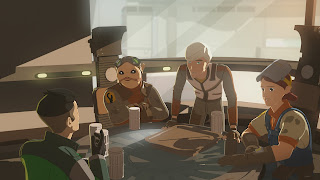Originally published on Set The Tape
The IDW run on Ghostbusters has been a great series, introducing many new elements to the mythology, from new and diverse characters and a deeper exploration of the characters’ backgrounds, to new villains that expand the world. If you’ve not read any of the IDW run before, Ghostbusters: Spectral Shenanigans is a good place to jump into it. It might not be the first things that IDW have done with the characters or the universe, but it is the start of their ‘Volume 1’ series, written by Erik Burnham.
The book collects together the first 12 issues of the series and sets the Ghostbusters off on their next big series of events. Things begin with the team having to go up against their first big villain once again, Gozer the Gozerian. Enraged that they were forced to take on the form of the Stay Puft Marshmallow Man when it came to destroy the world, Gozer has come back for a second attempt, this time sending a new minion, Idulnas, to force Ray to pick a new form for Gozer to take.
This story adds some interesting new tweaks to the mythology, and it’s good to start the series by bringing back something that people will be familiar with from the films. It’s also a nice explanation of why Ray wasn’t to blame because he couldn’t clear his mind whilst the others could, but that he was always the one who was going to pick Gozer’s form due to a closer connection to the world of the paranormal. This also explains why Ray was the one possessed by the villain in the second movie, as more than just ‘this keeps happening to Ray’.
From this initial story we discover that the Ghostbusters have also become contractors for the city, and that a side-effect of this is that the city is sending them outside of New York in order to help on other big cases, partially because the city can charge people for this. Thus begins a cross-country road-trip that sees the gang fighting ghosts across America.
It’s a great new addition to the series, one that means the action can easily shift outside of the New York setting without having to have clients come in to hire them; they can just be somewhere else and we know it’s because the city have hired them out. It means that the book has a lot more variety to it, and can even make use of some regional ghost stories. For example, in one of the issues they travel to Roswell and come up against what appears to be alien ghosts, complete with an alien obsessed FBI agent that looks like David Duchovny; whilst in another they delve into the real life ghost story of New Orleans Voodoo Queen Marie Laveau.
Despite showcasing a series of great one-off adventures, the book contains an ongoing mystery that is seeded throughout: a huge increase in paranormal activity. Egon investigates this and believes that he comes up with an answer – an old friend of his from college who should be dead but is somehow still alive. When it turns out that the guy trapped death in a bag when he came to reap his soul, Egon believes this is the reason why there are so many spirits in the world now.
Whilst this situation isn’t resolved by the end of the book, with Egon’s friend demanding proof that him still being alive is causing something bad, before letting death free, it’s sure to be a plot thread that will continue on into further volumes of the series. The companion issue that expands upon this concept by using diary entries from an expedition into Siberia in 1912 is one of the best in the book, with a really creepy tale and dark art-style that makes it stand out from everything else.
A great collection that brings together a year’s worth of adventures from the Ghostbusters team, Ghostbusters: Spectral Shenanigans is a great book for those who have already been reading the IDW series, as well as a perfect entry point for new fans.
Buy Amy A Coffee
Go to Amy's Blog





































